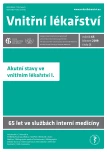Intravenous fluid therapy in acutely ill patients for non-intensivists
Authors:
Martin Matějovič 1,2; Jan Horák 1,2; Martin Harazim 1,2; Thomas Karvunidis 1,2; Jaroslav Raděj 1,2; Ivan Novák 1
Authors‘ workplace:
I. interní klinika LF UK a FN Plzeň
1; Biomedicínské centrum LF UK, Plzeň
2
Published in:
Vnitř Lék 2019; 65(3): 187-192
Category:
Overview
Intravenous fluid therapy is the most frequent therapeutic intervention in acutely hospitalized patients. They are administered in order to resuscitate the circulation in hypovolemia-associated shock states, to compensate for an impending or existing fluid extracellular deficit, or as a maintenance infusion if the patient is incapable of taking fluid by other means. Any fluid should be prescribed with the same caution as with any other drug. Errors in fluid therapy adversely affect patient – centered outcome. This may be the result of an incorrectly selected amount or inappropriate fluid composition for a given clinical situation. Prescribing intravenous fluids is a complex process involving a decision on the type, composition, dose, rate and possible toxicity of the particular solution. Balanced crystalloid solutions are the first choice for most acute conditions. The need for fluids dynamically changes over time in acutely ill patients. Uncontrolled cumulative positive balance is associated with substantial morbidity and mortality.
Keywords:
colloids – crystalloids – fluid resuscitation – fluid therapy
Sources
-
Kellum JA. Abnormal saline and the history of intravenous fluids. Nat Rev Nephrol 2018; 14(6): 358–360. Dostupné z DOI: <http://dx.doi.org/10.1038/s41581–018–0008–4>.
-
Glassford NJ, Bellomo R. Does Fluid Type and Amount Affect Kidney Function in Critical Illness? Crit Care Clin 2018; 34(2): 279–298. Dostupné z DOI: <http://dx.doi.org/10.1016/j.ccc.2017.12.006>.
-
Semler MW, Self WH, Wanderer JP et al. [SMART Investigators and the Pragmatic Critical Care Research Group]. Balanced Crystalloids versus Saline in Critically Ill Adults. N Engl J Med 2018; 378(9): 829–839. Dostupné z DOI: <http://dx.doi.org/10.1056/NEJMoa1711584>.
-
Self WH, Semler MW, Wanderer JP et al. [SALT-ED Investigators]. Balanced Crystalloids versus Saline in Noncritically Ill Adults. N Engl J Med 2018; 378(9): 819–828. Dostupné z DOI: <http://dx.doi.org/10.1056/NEJMoa1711586>.
-
Morgan TJ. The ideal crystalloid – what is ‚balanced‘? Curr Opin Crit Care 2013; 19(4): 299–307. Dostupné z DOI: <http://dx.doi.org/10.1097/MCC.0b013e3283632d46>.
-
Myburgh JA, Mythen MG. Resuscitation fluids. N Engl J Med 2013; 369(13): 1243–1251. Dostupné z DOI: <http://dx.doi.org/10.1056/NEJMra1208627>.
-
Rochwerg B, Alhazzani W, Gibson A et al. [FISSH Group (Fluids in Sepsis and Septic Shock)]. Fluid type and the use of renal replacement therapy in sepsis: a systematic review and network meta-analysis. Intensive Care Med 2015; 41(9): 1561–1571. Dostupné z DOI: <http://dx.doi.org/10.1007/s00134–015–3794–1>.
-
Moeller C, Fleischmann C, Thomas-Rueddel D et al. How safe is gelatin? A systematic review and meta-analysis of gelatin-containing plasma expanders vs crystalloids and albumin. J Crit Care 2016; 35: 75–83. Dostupné z DOI: <http://dx.doi.org/10.1016/j.jcrc.2016.04.011>.
-
Moritz ML, Ayus JC. Maintenance Intravenous Fluids in Acutely Ill Patients. N Engl J Med 2015; 373(14): 1350–1360. Dostupné z DOI: <http://dx.doi.org/10.1056/NEJMra1412877>.
-
Weinberg L, Harris L, Bellomo R et al. Effects of intraoperative and early postoperative normal saline or Plasma-Lyte 148® on hyperkalaemia in deceased donor renal transplantation: a double-blind randomized trial. Br J Anaesth 2017; 119(4): 606–615. Dostupné z DOI: <http://dx.doi.org/10.1093/bja/aex163>.
-
Prowle JR, Kirwan CJ, Bellomo R. Fluid management for the prevention and attenuation of acute kidney injury. Nat Rev Nephrol 2014; 10(1): 37–47. Dostupné z DOI: <http://dx.doi.org/10.1038/nrneph.2013.232>.
Labels
Diabetology Endocrinology Internal medicineArticle was published in
Internal Medicine

2019 Issue 3
Most read in this issue
- Hemorrhagic shock and treatment of severe bleeding
- Intravenous fluid therapy in acutely ill patients for non-intensivists
- Acute respiratory distress syndrome
- Diagnosing hypovolemia and hypervolemia: from clinical examination to modern methods
